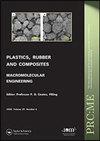Marble waste reinforced composite with tunable physico-mechanical and thermal properties: micromechanical simulation assisted experimental investigation
IF 1.2
4区 材料科学
Q3 MATERIALS SCIENCE, COMPOSITES
引用次数: 0
Abstract
ABSTRACT This paper investigates the development of waste marble dust-reinforced particulate composites through an integrated approach of investigation. Samples of marble-epoxy composites were prepared with systematic variations in filler content to achieve tunable mechanical, physical, and thermal properties. Increasing ceramic filler's loading level resulted in superior properties of composite samples, as demonstrated by macroscale characterization such as compressive and flexural strength. Microstructural characterizations such as Fourier transform infrared spectroscopy (FT-IR), Field emission scanning electron microscopy (FE-SEM), thermogravimetric analysis (TGA), and X-ray diffraction (XRD) analysis were used to better understand the results. FT-IR results indicate chemical linkages forming between the epoxy resin and marble dust in the composite, while FE-SEM images suggest strong interfacial bonding between filler and matrix. TGA analysis shows enhancement of thermal properties with increasing filler content, while XRD indicates enhancement of crystallinity. Micro-mechanical modeling using the representative volume element (RVE) approach was also carried out using a commercial simulation package, determining Young’s modulus and comparing it with experimental results. GRAPHICAL ABSTRACT具有可调物理力学和热性能的废大理石增强复合材料:微力学模拟辅助实验研究
摘要:本文采用综合研究方法,研究了废大理石粉尘增强颗粒复合材料的发展情况。大理石-环氧复合材料的样品制备与系统变化的填料含量,以实现可调的机械,物理和热性能。增加陶瓷填料的加载水平,复合材料的抗压强度和抗折强度等宏观表征均表现出优异的性能。显微结构表征,如傅里叶变换红外光谱(FT-IR)、场发射扫描电镜(FE-SEM)、热重分析(TGA)和x射线衍射(XRD)分析被用来更好地理解结果。FT-IR结果表明复合材料中环氧树脂和大理石粉尘之间形成了化学键合,而FE-SEM图像表明填料和基体之间存在很强的界面键合。TGA分析表明,随着填料含量的增加,材料的热性能增强;XRD分析表明,结晶度增强。利用商业仿真包,采用代表性体积元(RVE)方法进行微力学建模,确定杨氏模量并与实验结果进行比较。图形抽象
本文章由计算机程序翻译,如有差异,请以英文原文为准。
求助全文
约1分钟内获得全文
求助全文
来源期刊

Plastics, Rubber and Composites
工程技术-材料科学:复合
CiteScore
4.10
自引率
0.00%
发文量
24
审稿时长
4 months
期刊介绍:
Plastics, Rubber and Composites: Macromolecular Engineering provides an international forum for the publication of original, peer-reviewed research on the macromolecular engineering of polymeric and related materials and polymer matrix composites. Modern polymer processing is increasingly focused on macromolecular engineering: the manipulation of structure at the molecular scale to control properties and fitness for purpose of the final component. Intimately linked to this are the objectives of predicting properties in the context of an optimised design and of establishing robust processing routes and process control systems allowing the desired properties to be achieved reliably.
 求助内容:
求助内容: 应助结果提醒方式:
应助结果提醒方式:


